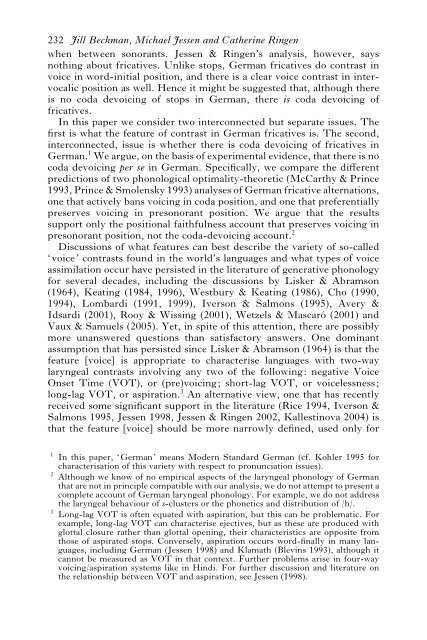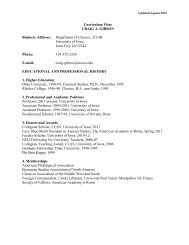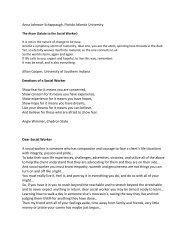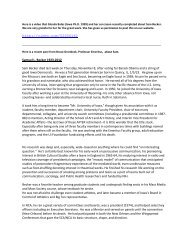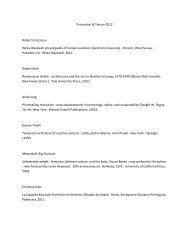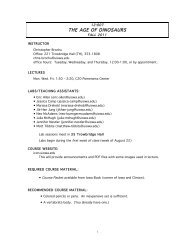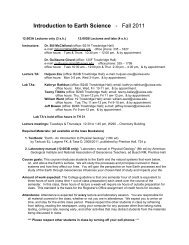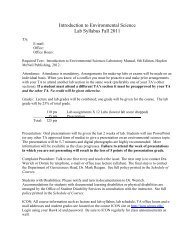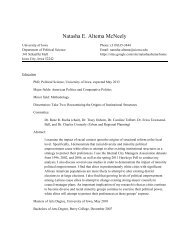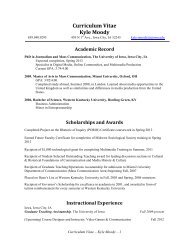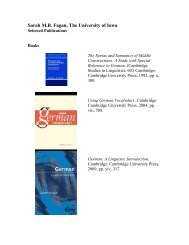German fricatives: coda devoicing or positional faithfulness?
German fricatives: coda devoicing or positional faithfulness?
German fricatives: coda devoicing or positional faithfulness?
You also want an ePaper? Increase the reach of your titles
YUMPU automatically turns print PDFs into web optimized ePapers that Google loves.
232 Jill Beckman, Michael Jessen and Catherine Ringen<br />
when between son<strong>or</strong>ants. Jessen & Ringen’s analysis, however, says<br />
nothing about <strong>fricatives</strong>. Unlike stops, <strong>German</strong> <strong>fricatives</strong> do contrast in<br />
voice in w<strong>or</strong>d-initial position, and there is a clear voice contrast in intervocalic<br />
position as well. Hence it might be suggested that, although there<br />
is no <strong>coda</strong> <strong>devoicing</strong> of stops in <strong>German</strong>, there is <strong>coda</strong> <strong>devoicing</strong> of<br />
<strong>fricatives</strong>.<br />
In this paper we consider two interconnected but separate issues. The<br />
first is what the feature of contrast in <strong>German</strong> <strong>fricatives</strong> is. The second,<br />
interconnected, issue is whether there is <strong>coda</strong> <strong>devoicing</strong> of <strong>fricatives</strong> in<br />
<strong>German</strong>.1 We argue, on the basis of experimental evidence, that there is no<br />
<strong>coda</strong> <strong>devoicing</strong> per se in <strong>German</strong>. Specifically, we compare the different<br />
predictions of two phonological optimality-the<strong>or</strong>etic (McCarthy & Prince<br />
1993, Prince & Smolensky 1993) analyses of <strong>German</strong> fricative alternations,<br />
one that actively bans voicing in <strong>coda</strong> position, and one that preferentially<br />
preserves voicing in preson<strong>or</strong>ant position. We argue that the results<br />
supp<strong>or</strong>t only the <strong>positional</strong> <strong>faithfulness</strong> account that preserves voicing in<br />
preson<strong>or</strong>ant position, not the <strong>coda</strong>-<strong>devoicing</strong> account.2<br />
Discussions of what features can best describe the variety of so-called<br />
‘voice’ contrasts found in the w<strong>or</strong>ld’s languages and what types of voice<br />
assimilation occur have persisted in the literature of generative phonology<br />
f<strong>or</strong> several decades, including the discussions by Lisker & Abramson<br />
(1964), Keating (1984, 1996), Westbury & Keating (1986), Cho (1990,<br />
1994), Lombardi (1991, 1999), Iverson & Salmons (1995), Avery &<br />
Idsardi (2001), Rooy & Wissing (2001), Wetzels & Mascaró (2001) and<br />
Vaux & Samuels (2005). Yet, in spite of this attention, there are possibly<br />
m<strong>or</strong>e unanswered questions than satisfact<strong>or</strong>y answers. One dominant<br />
assumption that has persisted since Lisker & Abramson (1964) is that the<br />
feature [voice] is appropriate to characterise languages with two-way<br />
laryngeal contrasts involving any two of the following: negative Voice<br />
Onset Time (VOT), <strong>or</strong> (pre)voicing; sh<strong>or</strong>t-lag VOT, <strong>or</strong> voicelessness;<br />
long-lag VOT, <strong>or</strong> aspiration.3 An alternative view, one that has recently<br />
received some significant supp<strong>or</strong>t in the literature (Rice 1994, Iverson &<br />
Salmons 1995, Jessen 1998, Jessen & Ringen 2002, Kallestinova 2004) is<br />
that the feature [voice] should be m<strong>or</strong>e narrowly defined, used only f<strong>or</strong><br />
1 In this paper, ‘<strong>German</strong>’ means Modern Standard <strong>German</strong> (cf. Kohler 1995 f<strong>or</strong><br />
characterisation of this variety with respect to pronunciation issues).<br />
2 Although we know of no empirical aspects of the laryngeal phonology of <strong>German</strong><br />
that are not in principle compatible with our analysis, we do not attempt to present a<br />
complete account of <strong>German</strong> laryngeal phonology. F<strong>or</strong> example, we do not address<br />
the laryngeal behaviour of s-clusters <strong>or</strong> the phonetics and distribution of /h/.<br />
3 Long-lag VOT is often equated with aspiration, but this can be problematic. F<strong>or</strong><br />
example, long-lag VOT can characterise ejectives, but as these are produced with<br />
glottal closure rather than glottal opening, their characteristics are opposite from<br />
those of aspirated stops. Conversely, aspiration occurs w<strong>or</strong>d-finally in many languages,<br />
including <strong>German</strong> (Jessen 1998) and Klamath (Blevins 1993), although it<br />
cannot be measured as VOT in that context. Further problems arise in four-way<br />
voicing/aspiration systems like in Hindi. F<strong>or</strong> further discussion and literature on<br />
the relationship between VOT and aspiration, see Jessen (1998).


